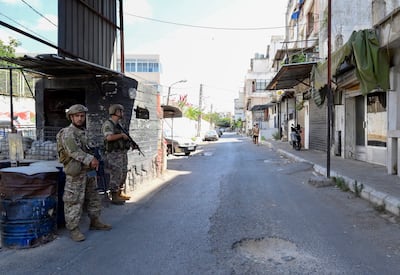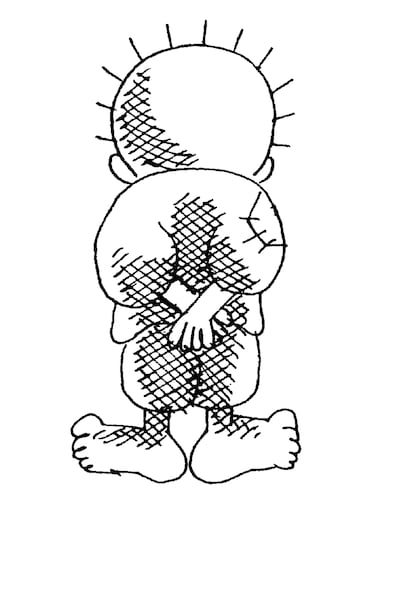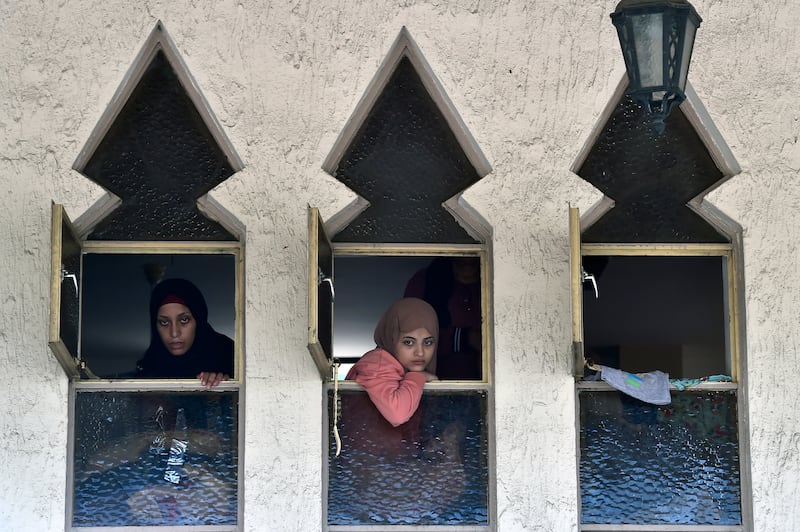The mood was tense in the streets and alleys of Ain Al Hilweh, Lebanon’s largest Palestinian refugee camp, on Wednesday, with residents bracing for another round of battles between armed Palestinian groups and Islamist factions.
The camp's roughly 50,000 registered refugees had been on edge since Tuesday as the deadline passed for the multinational, Al Qaeda-affiliated Islamist factions to surrender the killers of Abu Ashraf Al Armoushi, a commander of the Palestinian Fatah faction whose assassination in late July triggered a week of fighting.
But Mr Al Armoushi’s killers were not handed over. Instead, since the fighting ended, members of the Islamist faction have been fortifying their positions inside two UN compounds within the camp.
Fatah, the party of Palestinian Authority President Mahmoud Abbas, had promised deadly retribution if Mr Al Armoushi’s killers did not surrender.
“You can already see the preparations,” said Ola, a homemaker who grew up in the camp and now resides right outside its boundaries. “They’ve begun building trenches and fortifications out of barrels and sandbags, so you can tell they’re preparing for a battle”.
She said many of the camp's residents had recently left the area for fear of renewed fighting.
At least 13 people were killed and more than 2,000 displaced following deadly armed clashes between armed factions, among them Jund Al Sham, earlier this month.

Fatah, along with various other factions in the camp, issued a statement on Tuesday evening stressing their unity in ensuring Mr Al Armoushi's killers are brought to justice.
The statement also called on the displaced residents to return to the camp and resume their normal lives.
“There is no problem inside the camp neighbourhoods,” it said, citing Al Tameer as an exception because of the presence of Islamist groups there.
There were reports of gunfire inside the camp shortly after the statement was issued.
A member of Ain Al Hilweh’s Popular Committees, a group of representatives from various Palestinian factions who govern the camp, scoffed at the statement.
“They’re saying any battle will be contained to one neighbourhood? There’s no such thing,” he said.
He declined to be identified, fearing retribution from both Fatah and the Islamist groups.
Another source, privy to meetings of the Palestinian Joint Action Committee, comprising representatives of political factions, told The National that a “strong response” against the Islamist factions should be expected.
Most of the camp’s residents expect fighting to erupt this week.
Armed groups reinforce
The member of the Popular Committees told The National that “Fatah has brought in soldiers from across all the other camps – from Rashidieh to Burj Shamali to Buss and Baddawi”.
“There isn't a soldier they didn't bring in,” the member said. “And the other side is strengthening itself militarily, too.”
The armed Islamist groups continue to barricade themselves in two UN-run education compounds, which host all eight schools inside the camp.
Even without active fighting, the limbo created by the surrender deadline has made life difficult for residents.
“The camp is economically paralysed,” said the member of the Popular Committees.
Residents are unable to come and go freely, he said, because the situation was unstable and armed factions were occupying certain areas. Cars are not permitted to enter the camp, and the upper main street – known as Fawkani street – is closed off.
“Either peace or war; not this tense limbo,” he said grimly, and added that residents were exhausted.
He said he feared the camp would be destroyed, which would prompt mass displacement and threaten the refugees' “right of return”.
Palestinians who were forcibly expelled from their land in 1948 during the creation of what is now Israel have their rights enshrined in Article 13(2) of the Universal Declaration of Human Rights.
Even after 75 years, many believe that their continued existence as refugees in camps across the region is a reminder that their status is only temporary. Some have kept the keys to their old homes, passing them on through the generations in the hope of one day returning to them.

Tuesday, the deadline given to Islamist groups to surrender Mr Al Armoushi’s assassins, was also the 36th anniversary of the assassination of Palestinian artist Naji Al Ali, who grew up in Ain Al Hilweh.
Al Ali, whose killers were never identified, remains famous for his caricatures, illustrating the plight of Palestinian refugees and their yearning to return through the character, Handala.
The ragged, barefoot 10-year-old boy is always depicted standing with his hands clutched behind his back and his back turned towards the viewer, symbolising the character’s contempt towards the international community for turning its back on Palestinian refugees and their right of return.
Ola, the Palestinian homemaker, said most of Ain Al Hilweh's residents do not have the luxury of yearning for the homeland these days.
“People are barely able to achieve stability. They think about how they’re going to earn enough to feed their families today. Or how they’re going to fix their homes after another clash.”







